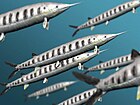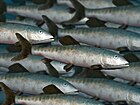Aspidorhynchiformes
| Aspidorhynchiformes Temporal range:
| |
|---|---|

| |
| Aspidorhynchus sanzenbacheri | |

| |
| Belonostomus kochii | |
| Scientific classification | |
| Kingdom: | Animalia |
| Phylum: | Chordata |
| Class: | Actinopterygii |
| Division: | †Aspidorhynchei |
| Order: | †Aspidorhynchiformes Bleeker, 1859 |
| Families | |
(For genera, see text) | |
Aspidorhynchiformes (meaning "shield snout form") is an extinct order of ray-finned fish. It contains only a single family, the Aspidorhynchidae. Members of the group are noted for their elongated, conical rostrums, of varying length, formed from fused premaxillae. They are generally interpreted as stem-group teleosts. The range of the group extends from the Middle Jurassic to the late Paleocene.
Taxonomic history[]
The order was described by Pieter Bleeker in 1859.
Aspidorhynchiformes has one family, which is divided into at least two genera:[1][2][3]
- Order †Aspidorhynchiformes Bleeker 1859 [Aspidorhynchida; Aspidorhynchoidei Bleeker 1859]
- Family †Aspidorhynchidae Bleeker 1859 [Vinctiferidae Silva Santos 1990; Diphyodontidae Jordan 1923]
- Genus †Jonoichthys Gouiric-Cavalli 2015
- Genus ?† Costa 1854
- Genus † Costa 1864
- Genus † Arratia 2015
- Genus † Bartholomai 2004
- Genus †Aspidorhynchus Agassiz 1833 non Fitzinger 1843
- Genus †Belonostomus Agassiz 1834 [ Costa 1856; Kner 1867 non Agassiz 1844 non Hodgson 1843; Diphyodus Lambe 1902]
- Genus †Vinctifer Jordan 1920
- Family †Aspidorhynchidae Bleeker 1859 [Vinctiferidae Silva Santos 1990; Diphyodontidae Jordan 1923]
Fossils range have been found in the United States, France, Italy, Russia, Saskatchewan, Alberta, North Dakota, Montana, Wyoming, and Uzbekistan. These fossils range from 167.7mya (Aspidorhynchus) to 66 mya (Belonostomus longirostris).
Anatomy[]

The most distinctive feature of the Aspidorhynchiformes are the elongated, tube-like rostrums, which are formed from fused premaxillary bones.[4] The scales are lepidosteoid, similar to those of gars.[5]
Taxonomy[]
Aspidorhynchiformes have generally been recovered as basal members of Teleosteomorpha, more closely related to teleosts than to Holostei. They have often considered to have a sister group relationship with Pachycormiformes, another group of basal teleosteomorphs.[6]
Evolutionary history[]
The earliest known remains of the group are known from the Middle Jurassic of Europe, in what was then the western Tethys Ocean, which was likely the centre of their initial diversification, during the Late Jurassic they dispersed to the waters around the Caribbean, South America and Antarctica.[4] During the Cretaceous they dispersed worldwide.[7] The youngest members the group, belonging to Belonostomus went extinct during the late Paleocene.[8]
References[]
- ^ Haaramo, Mikko (2007). "†Aspidorhynchiformes". Mikko's Phylogeny Archive. Retrieved 30 December 2016.
- ^ Nelson, Joseph S.; Grande, Terry C.; Wilson, Mark V. H. (2016). Fishes of the World (5th ed.). John Wiley & Sons. ISBN 9781118342336.
- ^ van der Laan, Richard (2016). "Family-group names of fossil fishes". Cite journal requires
|journal=(help) - ^ a b Cantalice, Kleyton M.; Alvarado-Ortega, Jesús; Brito, Paulo M.; Cantalice, Kleyton M.; Alvarado-Ortega, Jesús; Brito, Paulo M. (2018). "On the occurrence of Vinctifer ferrusquiai sp. nov. (Actinopterygii, Aspidorhynchiformes) in the Kimmeridgian (Late Jurassic) deposits near Tlaxiaco, Oaxaca, southern Mexico". Revista Mexicana de Ciencias Geológicas. 35 (2): 179–187. doi:10.22201/cgeo.20072902e.2018.2.713. ISSN 1026-8774. S2CID 51837850.
- ^ Brito, Paulo M.; Meunier, François J. (January 2000). "The morphology and histology of the scales of Aspidorhynchidae (Actinopterygii, Halecostomi)". Geobios. 33 (1): 105–111. doi:10.1016/S0016-6995(00)80153-9.
- ^ Peskin, Brianna; Henke, Katrin; Cumplido, Nicolás; Treaster, Stephen; Harris, Matthew P.; Bagnat, Michel; Arratia, Gloria (2020-07-20). "Notochordal Signals Establish Phylogenetic Identity of the Teleost Spine". Current Biology. 30 (14): 2805–2814.e3. doi:10.1016/j.cub.2020.05.037. ISSN 0960-9822. PMC 8159021. PMID 32559448.
- ^ Brito (1997) Brito PM. Révision des Aspidorhynchidae (Pisces, Actinopterygii) du Mésozoïque: ostéologie, relations phylogénétiques, données environnementales et biogéographiques. Geodiversitas. 1997;19:681–772.
- ^ Van Vranken, Nathan; Fielitz, Christopher; Ebersole, Jun (2019). "New occurrences of Belonostomus (Teleostomorpha: Aspidorhynchidae) from the Late Cretaceous of the North American Gulf Coastal Plain, USA". Palaeontologia Electronica. 22 (3): 1–11. doi:10.26879/983. ISSN 1935-3952. S2CID 204264731.
- Prehistoric ray-finned fish orders
- Prehistoric ray-finned fish stubs






